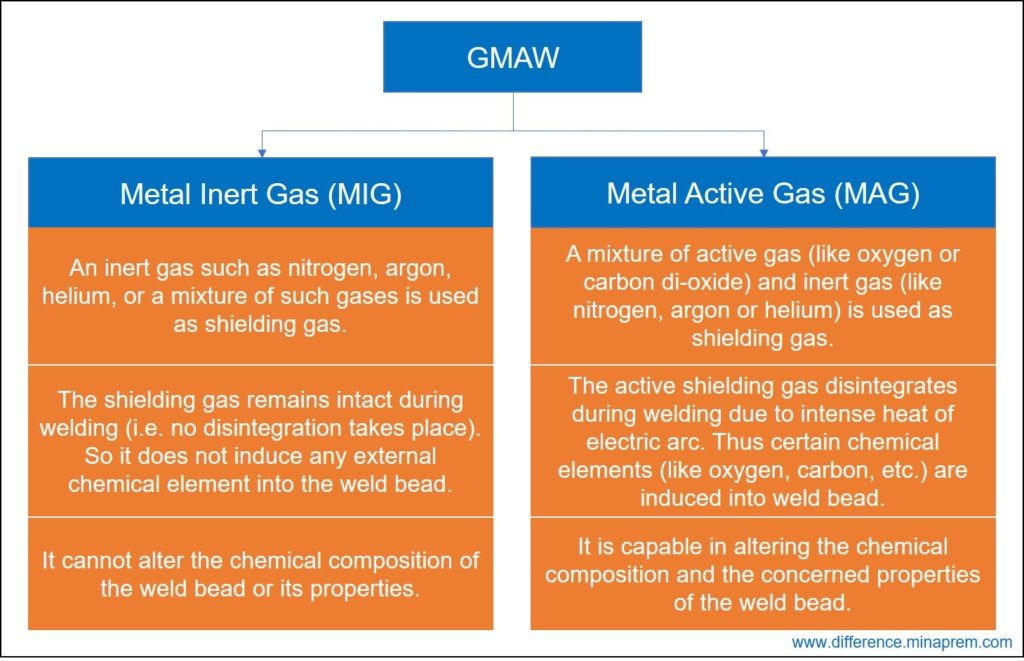Gas Metal Arc Welding (GMAW) is one fusion welding process where an electric arc is constituted between a consumable electrode and the base metals. This arc supplies necessary heat to melt down the faying surfaces of the base plate to form the coalescence. The GMAW electrode comes in the form of a small diameter wire having very long length that is wound in a wire-pool. During welding, this wire electrode is continuously fed to the welding zone to supply required filler metal to fill the root gap. Composition of the electrode metal is chosen based on the base metal – usually electrode has similar composition with that of base metals (as GMAW is preferred for homogeneous welding). Since GMAW employs bare electrode, so shielding gas is required to supply to the welding zone from an additional source in order to protect the hot weld bead from undesired oxidation and contamination. This shielding gas in GMAW process can be either inert or a mixture of active and inert gases. Based on the composition of shielding gas, GMAW process can be classified into two groups – Metal Inert Gas (MIG) welding and Metal Active Gas (MAG) welding.
As the name suggests, inert gas (like argon, helium, nitrogen, or a mixture of these gases) is used for shielding purpose in Metal Inert Gas (MIG) welding. Here the shielding gas remains stable during the welding and thus does not diffuse any external element into the weld bead. On the other hand, a mixture of active gas and inert gas is used for shielding purpose in Metal Active Gas (MAG) welding. Oxygen and carbon dioxide are two commonly used active gases for MAG welding. Such gases can disintegrate during welding due to extreme heat of the arc and can therefore induce chemical elements into the weld bead. Thus MAG welding gives the provision to alter chemical and mechanical properties of the weld bead. Few other benefits like deep penetration, stable arc, low spatter, etc. can also be harnessed in specific cases with the usage of active gases. The shielding gas composition is chosen in such a way that it gives desired impact in altering the composition of the weld bead. It is worth mentioning that both MIG and MAG welding processes are carried out in same way; the only difference lies in the composition of shielding gas and the consequent influences. Various similarities and differences between MIG and MAG welding processes are given below in table format.

Similarities between MIG and MAG welding
- MIG welding and MAG welding—both are arc welding processes (this indicates an electric arc is constituted between electrode and workpiece and this arc is the prime source of heat required to fuse faying surfaces of base metals). So both of them are fusion welding processes also.
- Both are Gas Metal Arc Welding (GMAW) processes. As mentioned earlier, GMAW is one type of arc welding process where a consumable electrode is continuously fed to the welding zone to supply filler metal. Metal Inert Gas (MIG) and Metal Active Gas (MAG) are two different types of GMAW processes.
- Shielding gas is necessary (and thus used) in both the cases; however, composition of shielding gas is different. In fact, constituent of shielding gas is primary factor for classifying GMAW process as MIG and MAG.
- Both of them utilize a consumable electrode that is continuously fed to the welding zone to supply necessary filler metal.
- Since filler is inherently applied, so none of them can be used for autogenous mode welding (where no filler metal is used). Typically, MIG and MAG are used for homogenous mode welding (where chemical composition of filler is similar to that of base metal).
- Spatter is produced in both the cases.
- Both the processes fetch more or less same depth of penetration.
Differences between MIG and MAG welding
| MIG Welding | MAG Welding |
|---|---|
| A chemically inert gas such as nitrogen, argon, helium, or a mixture of such gases is used as shielding gas in Metal Inert Gas (MIG) welding. | A mixture of chemically active gas (like oxygen or carbon di-oxide) and inert gas (like nitrogen, argon or helium) is used as shielding gas in Metal Active Gas (MAG) welding. |
| Because of pure inert gas, the shielding gas remains intact during welding (i.e. no disintegration takes place). | Due to presence of active gas, a part of shielding gas chemically disintegrates during welding due to intense heat of electric arc. |
| Shielding gas does not induce any chemical element into the weld bead. | As the active shielding gas breaks down, certain chemical elements (like oxygen, carbon, etc.) are induced into weld bead. |
| It cannot alter the chemical composition of weld bead or its properties. | It is capable in changing chemical composition and thus properties of weld bead. This is sometimes undesirable, but sometimes it can be carried out intentionally to obtain intended properties of weld bead. |
| It is not flexible in terms of shielding gas (as only inert gas can be used). | It allows usage of that particular gas mixture as shielding gas which can give desired features (such as deeper penetration, less spatter, etc.). |
| Industrially pure inert gas cylinder is somewhat costlier. Accordingly, MIG welding process is less economic. | Shielding gas cylinder for MAG welding is comparatively cheaper. |
| MIG welding is preferred for joining non-ferrous metals (like aluminum). | MAG welding is preferred for joining ferrous metals (like mild steel or stainless steel). |
Reference
- Comprehensive Workshop Technology (Manufacturing Processes) by S. K. Garg (Laxmi Publications Private Limited).
- Manufacturing Technology: Foundry, Forming and Welding by P. N. Rao (Tata McGraw Hill Education Private Limited).
- A Text-Book of Welding Technology by O. P. Khanna (Dhanpat Rai Publications).